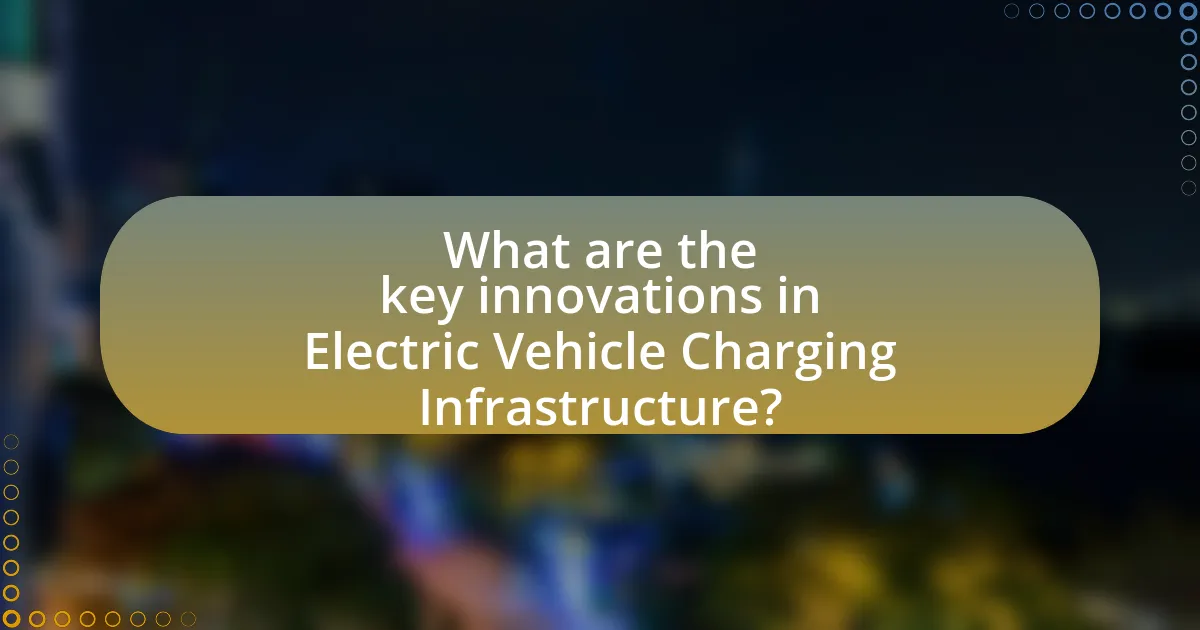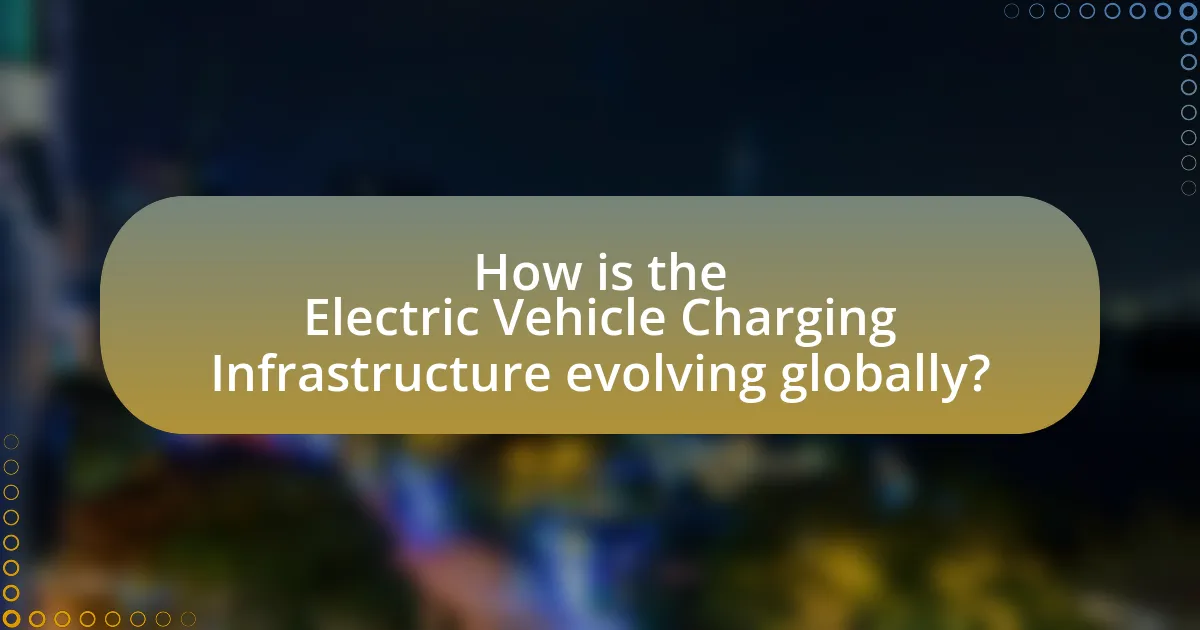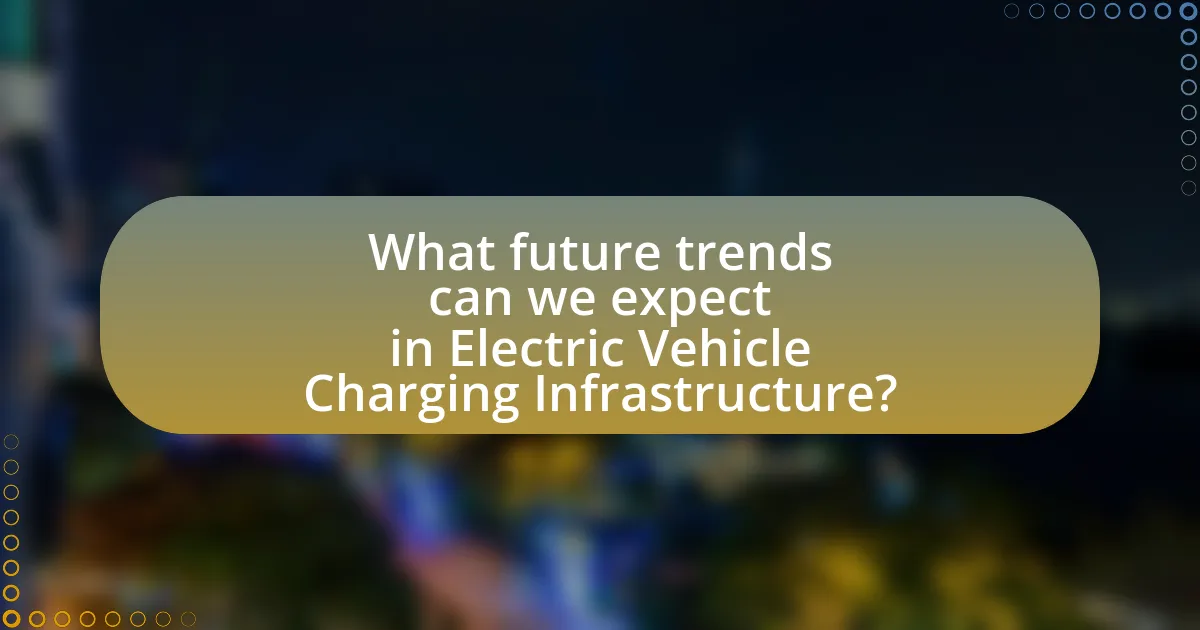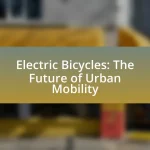The article focuses on key innovations in Electric Vehicle (EV) Charging Infrastructure, highlighting advancements such as ultra-fast charging technology, wireless charging systems, and smart grid integration. It discusses how these innovations enhance charging speed, accessibility, and sustainability, with fast-charging stations playing a crucial role in consumer adoption. The article also examines the various types of charging stations, the challenges faced in infrastructure development, and the impact of government incentives and private sector contributions. Additionally, it explores future trends, including the integration of smart technology and renewable energy, which are essential for the continued evolution of EV charging networks globally.

What are the key innovations in Electric Vehicle Charging Infrastructure?
Key innovations in Electric Vehicle Charging Infrastructure include ultra-fast charging technology, wireless charging systems, and smart grid integration. Ultra-fast charging technology enables charging rates of up to 350 kW, significantly reducing charging time to around 15-30 minutes for most electric vehicles. Wireless charging systems utilize inductive charging pads, allowing vehicles to charge without physical connections, enhancing convenience and usability. Smart grid integration facilitates real-time energy management, optimizing charging based on grid demand and renewable energy availability, which supports a more sustainable energy ecosystem. These innovations collectively enhance the efficiency, accessibility, and user experience of electric vehicle charging.
How have technological advancements influenced Electric Vehicle Charging Infrastructure?
Technological advancements have significantly enhanced Electric Vehicle (EV) charging infrastructure by improving charging speed, accessibility, and integration with renewable energy sources. Innovations such as fast-charging technology have reduced charging times from several hours to as little as 15-30 minutes, making EVs more convenient for users. For instance, the development of 350 kW chargers allows for rapid charging, which is crucial for long-distance travel. Additionally, advancements in smart charging systems enable real-time monitoring and management of energy consumption, optimizing the use of renewable energy and reducing costs. According to the International Energy Agency, the number of public charging points worldwide reached over 1.3 million in 2020, reflecting the rapid expansion of infrastructure driven by these technological improvements.
What role do fast-charging stations play in the evolution of charging infrastructure?
Fast-charging stations are pivotal in the evolution of charging infrastructure as they significantly reduce the time required to recharge electric vehicles. By providing high power output, these stations can charge a vehicle’s battery to 80% in approximately 30 minutes, compared to several hours with standard chargers. This rapid charging capability enhances the practicality of electric vehicles for long-distance travel, thereby increasing consumer adoption. According to the International Energy Agency, the number of fast-charging stations has grown exponentially, with over 30,000 stations installed globally by 2021, reflecting a critical shift towards more accessible and efficient charging solutions.
How is wireless charging technology changing the landscape of electric vehicle charging?
Wireless charging technology is revolutionizing electric vehicle charging by enabling convenient, contactless power transfer, which enhances user experience and accessibility. This technology eliminates the need for physical connectors, allowing vehicles to charge simply by parking over a charging pad, thus reducing wear and tear on charging ports and improving the longevity of both vehicles and charging infrastructure.
Moreover, studies indicate that wireless charging can facilitate dynamic charging, where vehicles receive power while in motion, potentially increasing the range and efficiency of electric vehicles. For instance, a project in Sweden demonstrated that buses could charge wirelessly while driving on specially equipped roads, showcasing the practical application of this technology in public transport systems.
Additionally, the integration of wireless charging into urban planning can lead to more efficient use of space, as charging pads can be installed in various locations, such as parking lots and roadways, making charging more accessible to users. This shift towards wireless solutions aligns with the growing demand for sustainable and user-friendly electric vehicle infrastructure, ultimately supporting the broader adoption of electric vehicles.
What are the different types of Electric Vehicle Charging Stations?
The different types of Electric Vehicle Charging Stations include Level 1, Level 2, and DC Fast Charging stations. Level 1 charging utilizes a standard 120-volt outlet and is typically used for home charging, providing about 4-5 miles of range per hour. Level 2 charging operates on a 240-volt outlet, commonly found in public charging stations, and can deliver 10-60 miles of range per hour, making it suitable for both residential and commercial use. DC Fast Charging stations, on the other hand, provide rapid charging capabilities, delivering 60-100 miles of range in just 20-30 minutes, and are primarily located along highways for long-distance travel. These classifications are recognized by the Society of Automotive Engineers (SAE) and are essential for understanding the charging infrastructure necessary for electric vehicles.
What distinguishes Level 1, Level 2, and DC fast charging stations?
Level 1, Level 2, and DC fast charging stations differ primarily in their charging speed and power output. Level 1 charging stations provide 120 volts and typically deliver 2 to 5 miles of range per hour, making them suitable for overnight charging at home. Level 2 stations operate at 240 volts and can charge an electric vehicle (EV) at a rate of 10 to 60 miles of range per hour, commonly found in public charging locations and workplaces. DC fast charging stations, on the other hand, utilize direct current and can provide 60 to 100 miles of range in just 20 minutes, making them ideal for long-distance travel and quick top-ups. This distinction in voltage and charging speed is crucial for users to select the appropriate charging solution based on their needs and usage patterns.
How do public charging stations differ from home charging solutions?
Public charging stations differ from home charging solutions primarily in their location, charging speed, and accessibility. Public charging stations are typically situated in commercial areas, highways, and public spaces, allowing for quick top-ups during travel, while home charging solutions are installed at residential properties, providing overnight charging convenience.
In terms of charging speed, public stations often offer fast or rapid charging options, capable of delivering significant power in a short time, such as 50 kW or more, enabling drivers to recharge their vehicles within 30 minutes. In contrast, home charging solutions usually operate at lower power levels, typically around 3.7 kW to 7.2 kW, which means they are designed for longer charging durations, often taking several hours to fully charge an electric vehicle.
Accessibility is another key difference; public charging stations are available to all electric vehicle users, while home charging solutions are limited to the specific household. This distinction is crucial as it affects the overall charging strategy for electric vehicle owners, influencing their choice between relying on public infrastructure or home installations.
What challenges are faced in the development of Electric Vehicle Charging Infrastructure?
The development of Electric Vehicle Charging Infrastructure faces several significant challenges, including high installation costs, limited grid capacity, and insufficient charging station availability. High installation costs can deter investment, as establishing a comprehensive network requires substantial financial resources. Limited grid capacity poses a challenge because many existing electrical grids may not support the increased demand from widespread electric vehicle charging. Additionally, insufficient charging station availability, particularly in rural or underserved areas, hampers the convenience and accessibility of electric vehicles, which is critical for consumer adoption. According to a report by the International Energy Agency, as of 2021, there were only 1.3 million public charging points globally, highlighting the need for expanded infrastructure to meet growing electric vehicle sales.
How do grid capacity and energy supply impact charging infrastructure expansion?
Grid capacity and energy supply significantly influence the expansion of charging infrastructure by determining the availability and reliability of power for electric vehicle charging stations. High grid capacity allows for the installation of more charging points, as it can handle increased electricity demand without overloading. Conversely, limited grid capacity can restrict the number of charging stations that can be deployed in a given area, leading to inadequate infrastructure for electric vehicle users.
For instance, a study by the International Energy Agency (IEA) indicates that regions with robust grid infrastructure and renewable energy sources can support a higher density of charging stations, facilitating the transition to electric vehicles. Additionally, energy supply stability ensures that charging stations can operate efficiently, reducing downtime and enhancing user experience. Thus, both grid capacity and energy supply are critical for the effective expansion of electric vehicle charging infrastructure.
What are the regulatory and policy hurdles affecting charging station deployment?
Regulatory and policy hurdles affecting charging station deployment include zoning restrictions, permitting processes, and lack of standardized regulations. Zoning restrictions can limit where charging stations can be installed, often requiring special permits that delay deployment. Permitting processes vary significantly across jurisdictions, leading to inconsistencies and increased costs for developers. Additionally, the absence of standardized regulations creates uncertainty for investors and operators, hindering the expansion of charging infrastructure. According to the National Renewable Energy Laboratory, these factors contribute to slower adoption rates of electric vehicle charging stations, impacting overall infrastructure development.

How is the Electric Vehicle Charging Infrastructure evolving globally?
The Electric Vehicle Charging Infrastructure is evolving globally through increased investment, technological advancements, and the expansion of charging networks. Governments and private companies are committing billions to build more charging stations, with the global market expected to reach $140 billion by 2030, driven by the rising demand for electric vehicles. Innovations such as fast-charging technology, which can charge vehicles in under 30 minutes, and wireless charging systems are being developed to enhance user convenience. Additionally, countries like China and the United States are leading in the deployment of charging stations, with China alone having over 1.5 million public charging points as of 2023. This evolution is crucial for supporting the transition to electric mobility and reducing greenhouse gas emissions.
What are the leading countries in Electric Vehicle Charging Infrastructure development?
The leading countries in Electric Vehicle Charging Infrastructure development are China, the United States, and Germany. China has the largest network of charging stations, with over 1.5 million public charging points as of 2023, driven by government policies promoting electric vehicle adoption. The United States follows with significant investments in charging infrastructure, including over 100,000 public charging stations, supported by initiatives like the Biden administration’s infrastructure plan. Germany ranks third, with a robust network of around 70,000 charging points, bolstered by its commitment to electric mobility and renewable energy integration. These countries are at the forefront of developing the necessary infrastructure to support the growing electric vehicle market.
How do government incentives influence the growth of charging networks in different regions?
Government incentives significantly accelerate the growth of charging networks across various regions by providing financial support and regulatory frameworks that encourage investment. For instance, in the United States, federal tax credits for electric vehicle charging stations have led to a substantial increase in the installation of these networks, with over 100,000 public charging outlets established by 2023. Additionally, state-level initiatives, such as California’s Clean Vehicle Rebate Project, further stimulate local infrastructure development by offering rebates to businesses and municipalities that install charging stations. These incentives create a favorable environment for private sector investment, resulting in a more extensive and accessible charging network, which is crucial for the adoption of electric vehicles.
What lessons can be learned from countries with advanced charging infrastructure?
Countries with advanced charging infrastructure demonstrate the importance of strategic planning and investment in technology to support electric vehicle adoption. For instance, Norway, which has the highest per capita number of electric vehicles, has implemented a comprehensive network of fast chargers, ensuring that 98% of the population lives within 30 kilometers of a charging station. This accessibility encourages EV usage and reduces range anxiety among consumers. Additionally, countries like the Netherlands have integrated charging stations into urban planning, promoting the use of public spaces for charging and ensuring that infrastructure keeps pace with increasing EV sales. These examples highlight that effective collaboration between government, private sector, and consumers is crucial for developing a robust charging network that meets the needs of electric vehicle users.
How are private companies contributing to Electric Vehicle Charging Infrastructure?
Private companies are significantly contributing to Electric Vehicle (EV) charging infrastructure by investing in the development and deployment of charging stations, creating innovative charging technologies, and forming strategic partnerships. For instance, companies like Tesla have established a widespread network of Superchargers, enabling long-distance travel for EV users, while ChargePoint operates one of the largest charging networks in the U.S., with over 114,000 charging locations. Additionally, firms such as Electrify America are investing billions in expanding fast-charging networks across the country, with a commitment to install 800 charging stations by 2025. These efforts not only enhance accessibility for EV users but also support the transition to sustainable transportation, as evidenced by the projected increase in EV adoption rates, which are expected to reach 30% of new car sales by 2030 according to the International Energy Agency.
What innovations are being introduced by startups in the charging space?
Startups in the charging space are introducing innovations such as ultra-fast charging technology, wireless charging solutions, and smart charging networks. Ultra-fast charging technology, exemplified by companies like Ionity, enables electric vehicles to charge up to 80% in under 20 minutes, significantly reducing downtime for users. Wireless charging solutions, developed by startups like WiTricity, utilize magnetic resonance to charge vehicles without physical connectors, enhancing convenience and user experience. Additionally, smart charging networks, implemented by companies such as ChargePoint, leverage data analytics and machine learning to optimize charging schedules and energy distribution, improving efficiency and grid stability. These innovations collectively aim to enhance the accessibility, speed, and convenience of electric vehicle charging infrastructure.
How are partnerships between automakers and charging networks shaping the future?
Partnerships between automakers and charging networks are significantly shaping the future of electric vehicle (EV) infrastructure by enhancing accessibility and convenience for consumers. These collaborations enable automakers to integrate charging solutions directly into their vehicles, ensuring that drivers have seamless access to charging stations. For instance, companies like Ford and Electrify America have established partnerships that provide Ford EV owners with access to a vast network of fast chargers, facilitating long-distance travel and reducing range anxiety. This strategic alignment not only accelerates the adoption of electric vehicles but also drives investment in charging infrastructure, as seen in the $7.5 billion allocated by the U.S. government for EV charging stations, which encourages further collaboration between automakers and charging providers.

What future trends can we expect in Electric Vehicle Charging Infrastructure?
Future trends in Electric Vehicle Charging Infrastructure include the expansion of ultra-fast charging stations, increased integration of renewable energy sources, and the development of smart charging technologies. Ultra-fast charging stations, capable of delivering 350 kW or more, are expected to significantly reduce charging times, making electric vehicles more convenient for users. The integration of renewable energy, such as solar and wind, will enhance sustainability and reduce reliance on fossil fuels, aligning with global climate goals. Smart charging technologies, which utilize real-time data to optimize charging schedules and manage energy loads, will improve grid efficiency and user experience. According to the International Energy Agency, the number of public charging points worldwide is projected to reach 10 million by 2030, reflecting the rapid growth and investment in this sector.
How will smart technology impact the future of Electric Vehicle Charging?
Smart technology will significantly enhance the future of Electric Vehicle (EV) charging by enabling more efficient, user-friendly, and integrated charging solutions. Smart charging systems will allow for real-time monitoring and management of energy consumption, optimizing charging times based on grid demand and electricity prices. For instance, according to a study by the International Energy Agency, smart charging can reduce costs for EV owners by up to 30% by utilizing off-peak electricity rates. Additionally, smart technology will facilitate vehicle-to-grid (V2G) capabilities, allowing EVs to return energy to the grid during peak demand, thus stabilizing the energy supply and enhancing grid resilience. This integration of smart technology into EV charging infrastructure will lead to a more sustainable and economically viable ecosystem for electric mobility.
What role will artificial intelligence play in optimizing charging station usage?
Artificial intelligence will play a crucial role in optimizing charging station usage by enhancing the efficiency of energy distribution and improving user experience. AI algorithms can analyze real-time data on vehicle charging patterns, station availability, and energy demand, allowing for dynamic pricing models that incentivize off-peak charging. For instance, a study by the International Energy Agency indicates that AI-driven systems can reduce charging wait times by up to 30% by predicting peak usage periods and adjusting resources accordingly. Additionally, AI can facilitate smart routing for electric vehicles, directing drivers to the nearest available charging station, thereby maximizing station utilization and minimizing downtime.
How can blockchain technology enhance the security and efficiency of charging networks?
Blockchain technology can enhance the security and efficiency of charging networks by providing a decentralized and immutable ledger for transactions. This technology ensures that all transactions related to charging sessions are securely recorded, reducing the risk of fraud and unauthorized access. For instance, smart contracts can automate payment processes, ensuring that users are charged accurately and instantly upon completion of a charging session. Additionally, blockchain’s transparency allows for real-time monitoring of charging station availability and usage, optimizing resource allocation and reducing downtime. Studies have shown that implementing blockchain in energy transactions can lead to a 20% increase in operational efficiency by streamlining processes and minimizing errors.
What are the best practices for users of Electric Vehicle Charging Infrastructure?
The best practices for users of Electric Vehicle Charging Infrastructure include planning charging sessions, using charging networks efficiently, and maintaining awareness of charging station availability. Users should plan their charging sessions based on their travel routes and the locations of charging stations to avoid running out of battery. Efficient use of charging networks involves selecting stations that offer the fastest charging speeds and are compatible with their vehicle. Additionally, users should utilize apps or websites that provide real-time information on charging station availability, which can help reduce wait times and improve the overall charging experience. These practices enhance convenience and ensure that users maximize the benefits of Electric Vehicle Charging Infrastructure.
How can electric vehicle owners maximize their charging efficiency?
Electric vehicle owners can maximize their charging efficiency by utilizing smart charging systems that optimize energy use based on grid demand and electricity rates. These systems can schedule charging during off-peak hours when electricity is cheaper and more abundant, reducing costs and strain on the grid. Additionally, owners should consider using Level 2 chargers, which provide faster charging times compared to standard Level 1 chargers, thus enhancing overall efficiency. According to the U.S. Department of Energy, Level 2 chargers can deliver 10 to 60 miles of range per hour, significantly improving charging efficiency for daily use.
What tips should users consider when selecting charging stations on the go?
When selecting charging stations on the go, users should prioritize the station’s charging speed, availability, and compatibility with their vehicle. Fast charging stations, such as those offering DC fast charging, can significantly reduce wait times, with some capable of charging a vehicle to 80% in about 30 minutes. Users should also check real-time availability through apps or websites to avoid wasted time at full stations. Additionally, ensuring compatibility with their electric vehicle’s charging port type is crucial, as not all stations support every vehicle model. According to the U.S. Department of Energy, there are over 41,000 public charging stations in the U.S., but users must verify that the station they choose meets their specific needs for a seamless charging experience.


